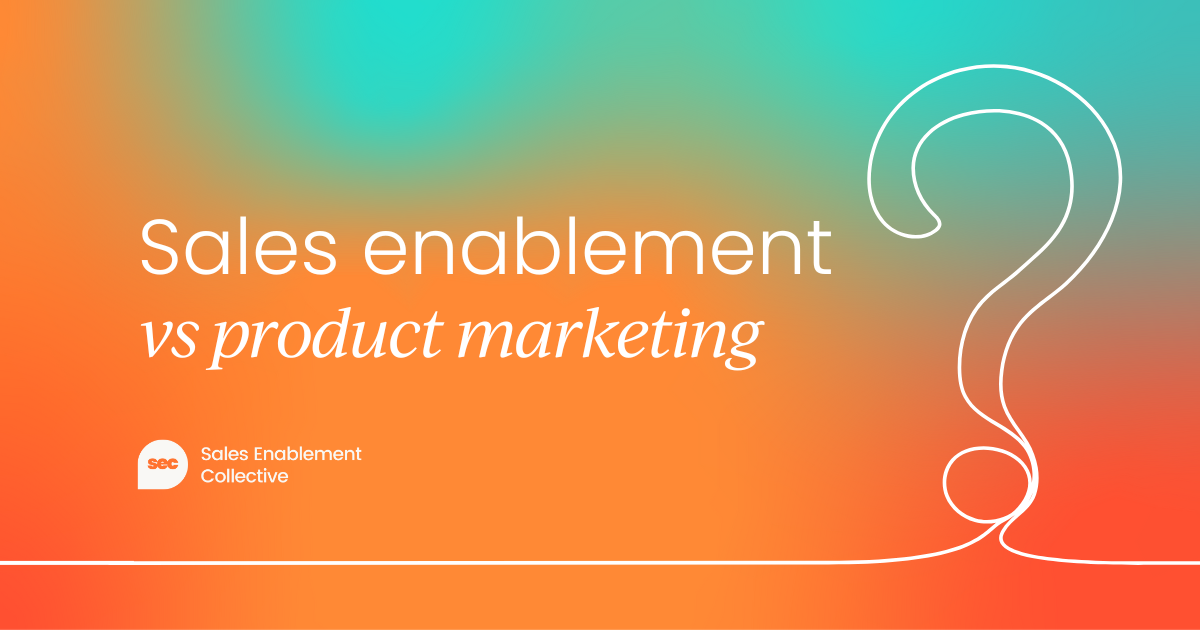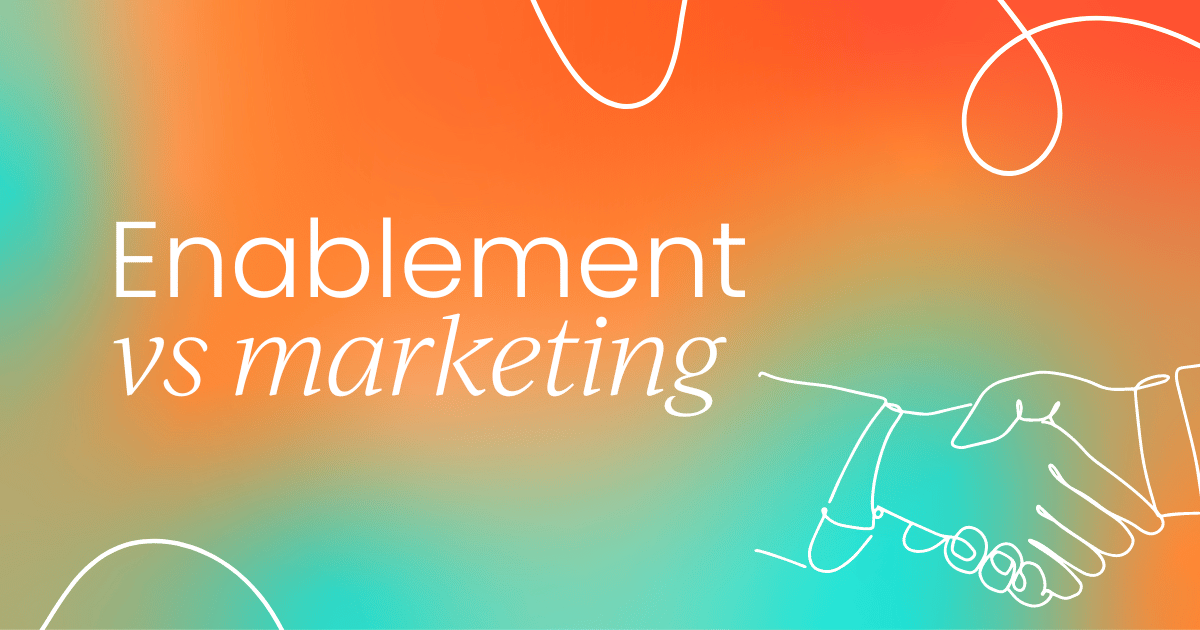Sales enablement is often mixed up with a few other terms, especially as it’s role in organizations isn’t always well defined.
Today we’ll discuss the differences between sales enablement and marketing, plus some details on how they can work together.
- Defining the terms
- Differences between the functions
- 4 ways marketing supports enablement
- Best practices for aligning enablement and marketing
- Sales enablement vs other marketing terms
Defining the terms
The first step in understanding the difference between sales enablement and marketing is to define the terms.
Marketing is the discipline of promoting a company’s products and services to a target market. This can involve advertising, lead generation, market research, content marketing, and pricing strategy.
Sales enablement is a support function tasked with providing sales teams with the resources they need to close deals and increase revenue. This involves training, coaching, onboarding, and creating sales collateral.
We know what you’re thinking…. “These don’t seem that similar.”
And you’d be correct. Sales enablement and marketing are two distinct functions with different roles in an organization. But they also work together to create alignment across the customer journey and drive revenue growth.
It’s this partnership that can cause confusion.
The differences between sales enablement and marketing
Now we understand the basics of marketing and sales enablement, let’s take a closer look at the differences between these functions.
Sales vs marketing expertise
We touched on this already, but enablers and marketers have different areas of expertise.
Marketing professionals are experts in promoting your products far and wide, and have the audience expertise to ensure your customers will love the campaign.
They’re also great copywriters and storytellers, helping craft the perfect product messaging across various marketing channels such as email, social media, blogs, and more.
Sales enablement professionals are experts in sales strategy and increasing seller productivity. They are well-versed in effective training and coaching methods that support reps to close deals.
They also understand how to structure learning initiatives to ensure information is retained and work with various formats of sales content to ensure sellers always have the information they need to hand.
Some types of sales content enablers produce include battlecards, playbooks, and sales scripts.
In short: marketing expertise vs sales expertise.
So combined, your sales enablement team and marketing team hold expertise in the customer journey from awareness to purchase. (We’ll cover this in more detail later.)
Day-to-day responsibilities
Next, we’ll dive into what these functions do on a day-to-day basis.
The responsibilities of your marketing team can be quite varied depending on the job title but in general, marketing professionals' tasks include:
- Strategy: Planning upcoming campaigns, defining product positioning, and other strategic initiatives.
- Social media: Creating and posting organic and paid content across social media platforms to create brand awareness.
- Email marketing: Sending promotional emails to a mailing list.
- Market research: Keeping an eye on market trends, competitor activity, and consumer behavior.
- Tracking performance: Measuring the success of marketing campaigns against metrics like click-through rate, engagement, and conversion rate.
Whereas, the daily responsibilities of your sales enablement team include:
- Strategy: Planning which programs and resources to create for the sales team and assisting sales leadership with the sales strategy.
- Content creation: Creating resources and sales collateral that sales reps can reference when they’re talking to prospects.
- Training: Delivering synchronous and asynchronous training programs to improve the sales team’s knowledge and skills.
- Onboarding: Training new sales reps on the processes and sales methodologies your org uses, and sharing vital product knowledge.
- Tracking performance: Measuring the success of enablement initiatives with metrics like sales productivity, sales velocity, and win/loss rates.
Key stakeholders
Sales enablement and marketing also have differing internal and external stakeholders.
Marketing teams work with the product team to ensure they’re highlighting the features and benefits of the offering to customers. They also collaborate with go-to-market teams to promote product launches.
Marketers also work with sales and customer success to ensure a smooth customer experience throughout the customer lifecycle. (They also collaborate with sales enablement on this, but let’s not get ahead of ourselves.)
However, the main stakeholder of the marketing team is external: prospective customers. Marketers must provide informative and appealing marketing content to their audience to increase brand awareness and conversions.
Sales enablers, on the other hand, work closely with the sales team to understand their needs and provide excellent training and resources to the team. They’ll also work with sales leaders to help refine sales processes and strategy.
Enablers may also work with revenue operations teams to optimize sales processes and onboard new sales technology.
Metrics and KPIs
We briefly mentioned some metrics sales enablement and marketing teams track but to fully understand their differing priorities, it’s best to take a deeper look.
Marketing teams track:
- Email metrics such as open rate, click-through rate (CTR), sign-ups, and unsubscribes.
- Social media metrics such as likes, shares, comments, and clicks.
- Conversion rates (how many people take action from the campaign) and marketing qualified leads (MQLs).
- Customer sentiment metrics such as no. of mentions and whether the mention was positive or negative.
- Paid media metrics such as cost per click (CPC) and return on investment (ROI).
These metrics help to track campaign performance and attribute some sales to the marketing team. When marketing teams can “prove” they impacted sales, they are likely to get increased support and budget from leadership.
Enablers, on the other hand, track metrics such as sales velocity, win/loss rates, and seller confidence. These metrics measure the performance of sales reps, which can show improvements in productivity after enablement programs.
Sales enablement pros may also track content usage to determine which pieces of sales content are most useful to sellers, allowing enablers to create more impactful collateral.
Stage of customer journey
Last but not least, a key difference between marketing and sales enablement is the stage of the customer journey they impact.
Marketing efforts focus primarily on the pre-purchase stage of the cycle, helping customers to funnel from awareness to consideration. Enablers impact sales reps’ ability to sell, meaning they positively influence the purchase stage of the buyer cycle.
4 ways marketing supports sales enablement
When the marketing and sales enablement functions work together, they can create excellent business outcomes and cross-functional alignment between sales and marketing.
Here are just four ways marketing can support their counterparts in enablement.
1. Define buyer personas
Marketers spend a significant amount of time on consumer research and understanding your org’s customers. With these insights, they create detailed buyer personas to help envision your ideal customer (think of these as your perfect fictional customers).
By defining these personas and creating a compelling story surrounding their lives, marketers help to bring the customer segments to life. In turn, making it easier for enablers to teach sales reps about their prospects.
With these buyer personas defined, enablers can create training materials to educate the sales team on your organization’s ideal customers and their pain points. This is especially useful when onboarding new salespeople.
2. Create effective content
Marketers are experts in external-facing promotional content. So it makes sense for them to help the sales enablement team create content sellers can use to convince their prospects to buy.
Whether it’s product brochures, written case studies, or video walkthroughs, the marketing team can produce excellent content to support the sales team. In partnership with sales enablement content, this client-facing collateral can lead to a higher win rate amongst sellers.
3. Share product knowledge
Marketing teams need to understand the product in order to promote it effectively, this means creating a relationship with the product team to understand how features work.
Sales enablement pros don’t typically have this close relationship with the product team, so often rely on their marketing peers to share new product knowledge.
Marketers might explain:
- The story behind a feature.
- The use cases of a new product/feature.
- How your product differs from a competitor’s.
- The best ways to describe a product/feature.
In turn, this will be shared with the sales team in the form of trainings and product cheat sheets.
4. Market research
With all the market research, social listening, and competitive intelligence your marketing team does, it’s no surprise they’re most up-to-date on what’s trending within your industry.
By spilling the tea on these crucial market changes, your enablement team can prepare the sales team for tricky customer questions or emerging trends in the market.
Best practices to align marketing and sales enablement
Now we understand the perks of aligning sales enablement and marketing, let’s discuss some best practices for implementing this cohesion in your org.
Align goals
An easy way to align your marketing and enablement teams is to create a shared goal they can work towards. Without this alignment, these teams may accidentally be working against each other.
For example, if your marketing team sets a goal to increase awareness and sales of Product A, and your sales and enablement team wants to focus on selling Product B, it’s likely neither team would hit their targets.
Communicating departmental goals allows these teams to work together to create better results (more on communication in a sec).
Communicate
It’s not revolutionary, but talking to each other can lead to fewer cross-departmental frustrations.
Some ideas of how to communicate better include:
- Setting up a shared channel to collaborate async, share insights/challenges/wins, and ask questions (that get answered).
- Creating a meeting cadence to collaborate and share ideas – this can be quarterly, monthly, or more frequently (if your teams just love meetings 😵💫).
- Provide more opportunities for feedback between departments, pair up enablers and marketers so they can occasionally send each other what they’re working on and get feedback from the other team.
Share customer feedback
Even more important than sharing feedback on each other’s work, is sharing insights from customers.
Both teams will hear feedback from your customers and prospects, but (as we discussed earlier) these are coming from different stages of the customer journey.
By sharing these insights and comments, your teams can form a better understanding of your customers across the entire buyer cycle. Leading to more targeted communications, and happier customers.
Sales enablement vs types of marketing
To round out this article, let’s quickly disambiguate a few more marketing terms that are commonly mixed up with sales enablement.
Sales enablement vs marketing enablement
Marketing enablement is focused on supporting and training marketing professionals to be better equipped in their roles.
The difference between sales enablement and marketing enablement is the focus of their efforts, to spell it out: sales enablement supports the sales team, and marketing enablement supports the marketing team.
In many organizations, these roles will be combined to create a revenue enablement team, which supports sales, marketing, and customer success pros.
Sales enablement vs content marketing
Content marketing is a sub-discipline of marketing focused on creating content such as blogs, podcasts, videos, infographics, and whitepapers to inform your audience.
This can be confused with sales enablement, as enablers also produce content. The difference is that enablers produce content to help sales reps close deals (for example, battlecards, cheatsheets, and sales playbooks), while content marketers focus on providing free content to increase brand awareness.
Sales enablement vs product marketing
Product marketing is another type of specialized marketing which is focused on managing product launches, messaging, and pricing.
The confusion arises as many product marketers also create sales content (or act as sales enablers in orgs without this function). But supporting sales is only a small part of a product marketer’s role, while it’s a greater part of an enabler’s.
Need more info? We covered these differences in more detail in this article. 👇


Sales enablement insider
Thank you for subscribing
Level up your sales enablement career & network with sales enablement experts
An email has been successfully sent to confirm your subscription.
 Follow us on LinkedIn
Follow us on LinkedIn


.png)












